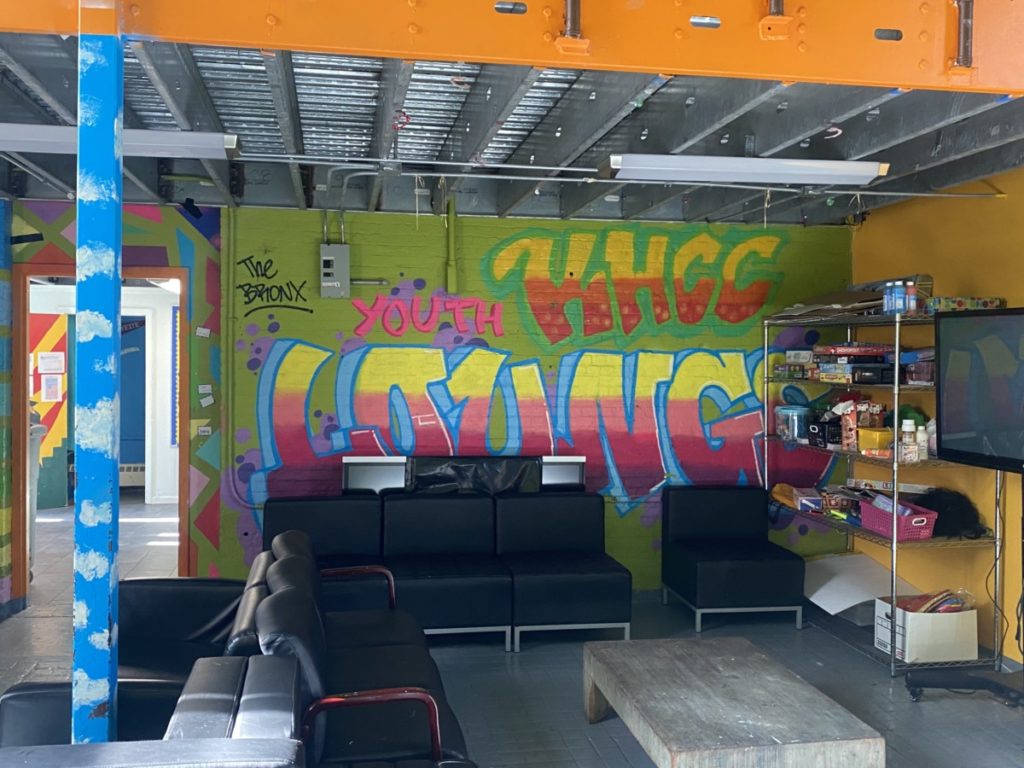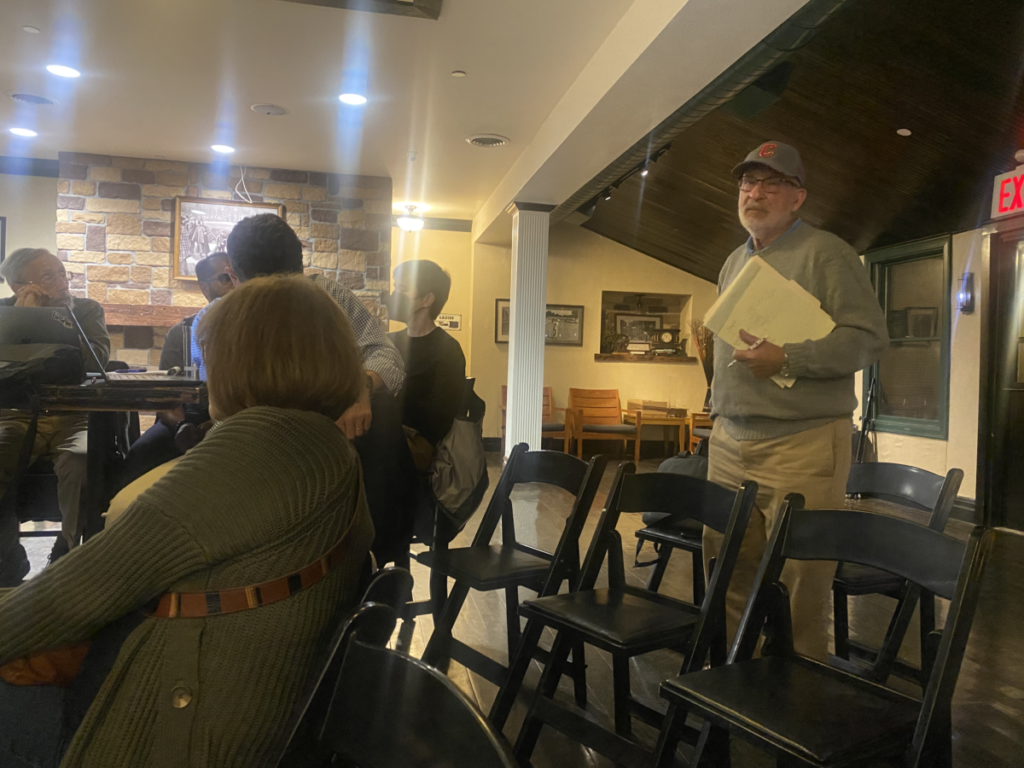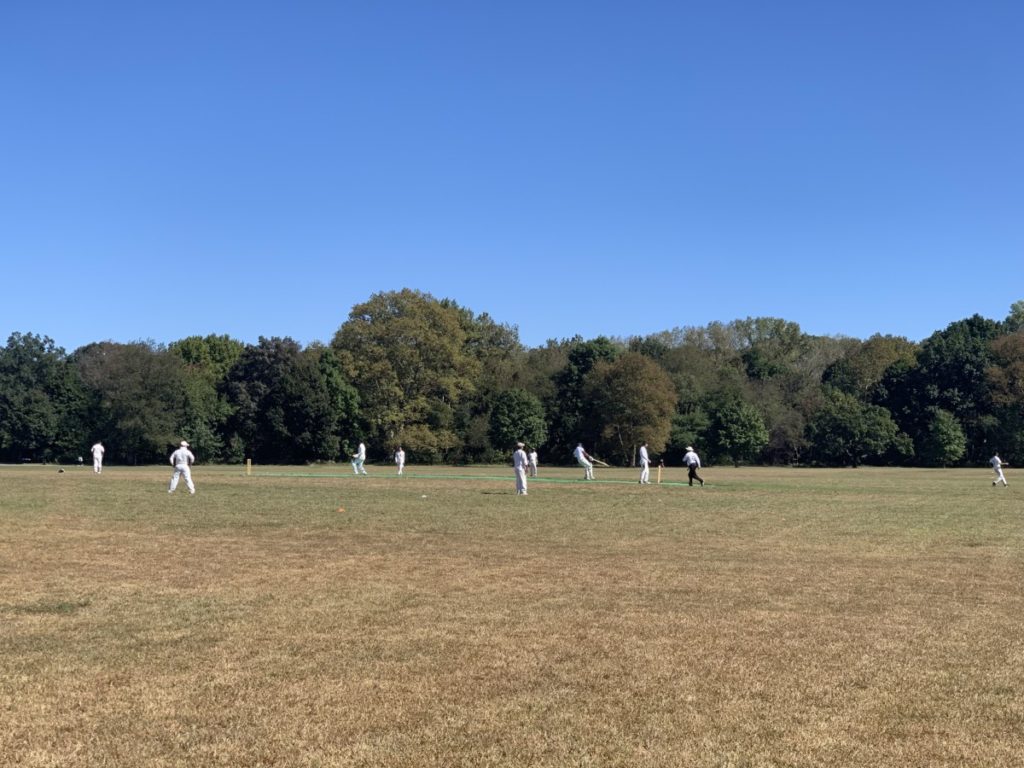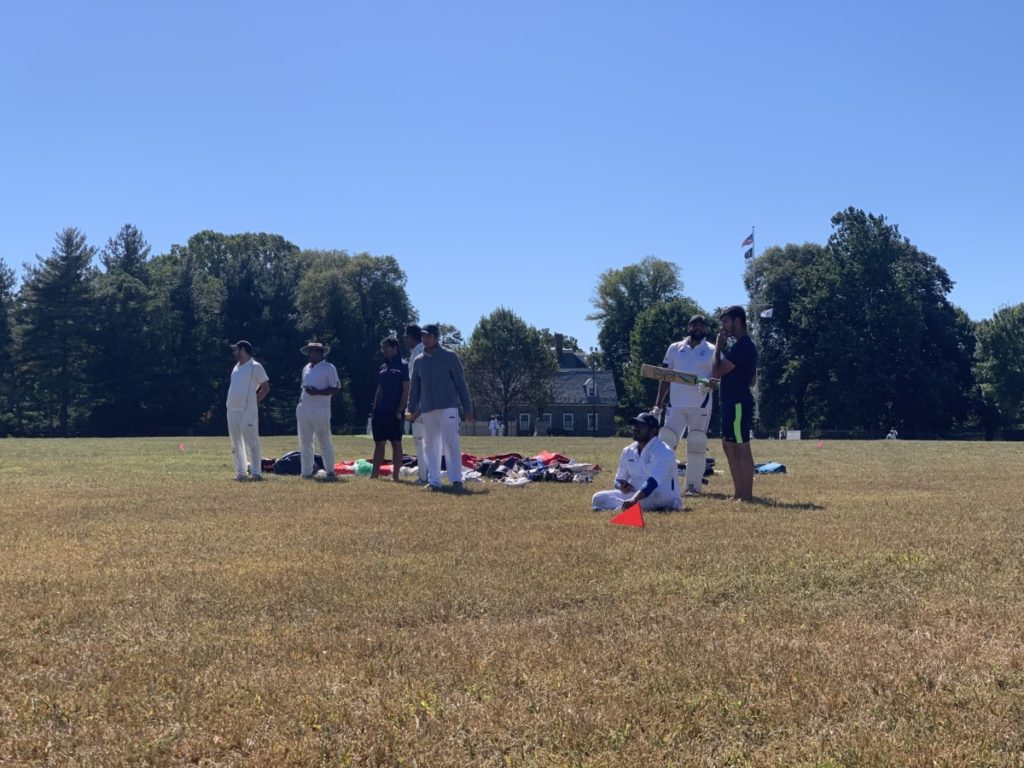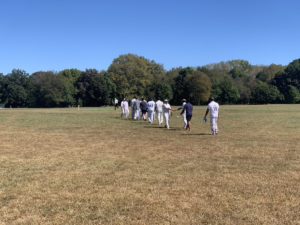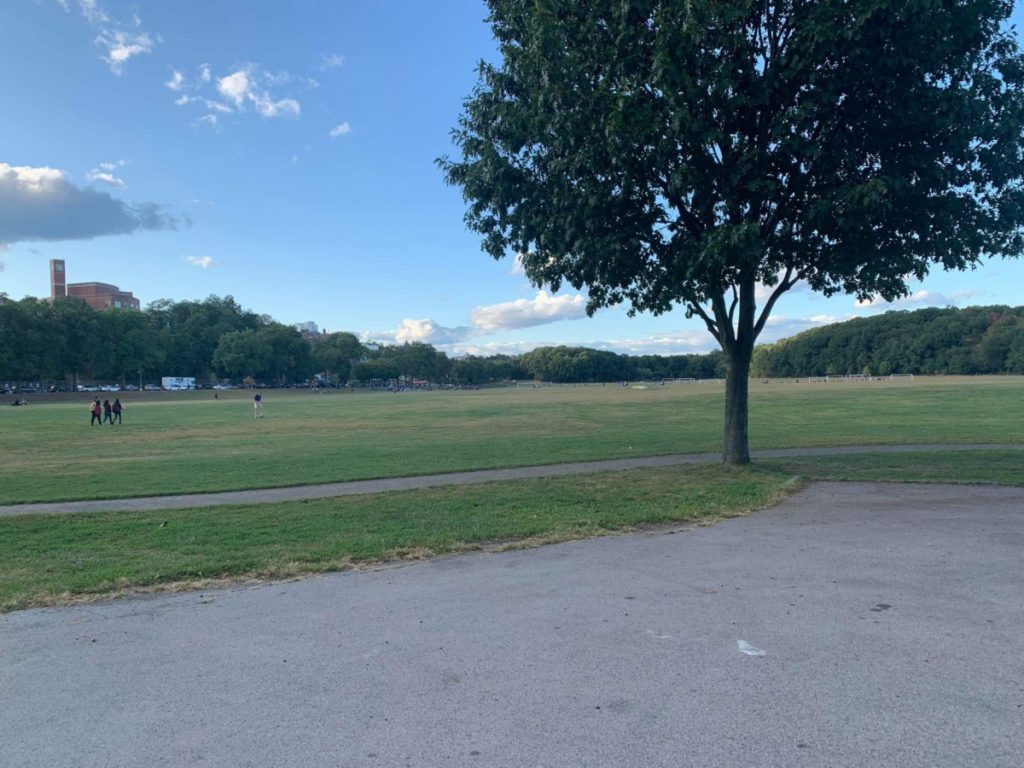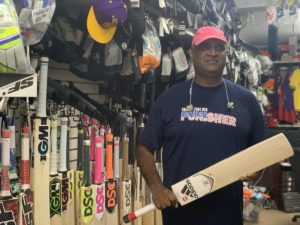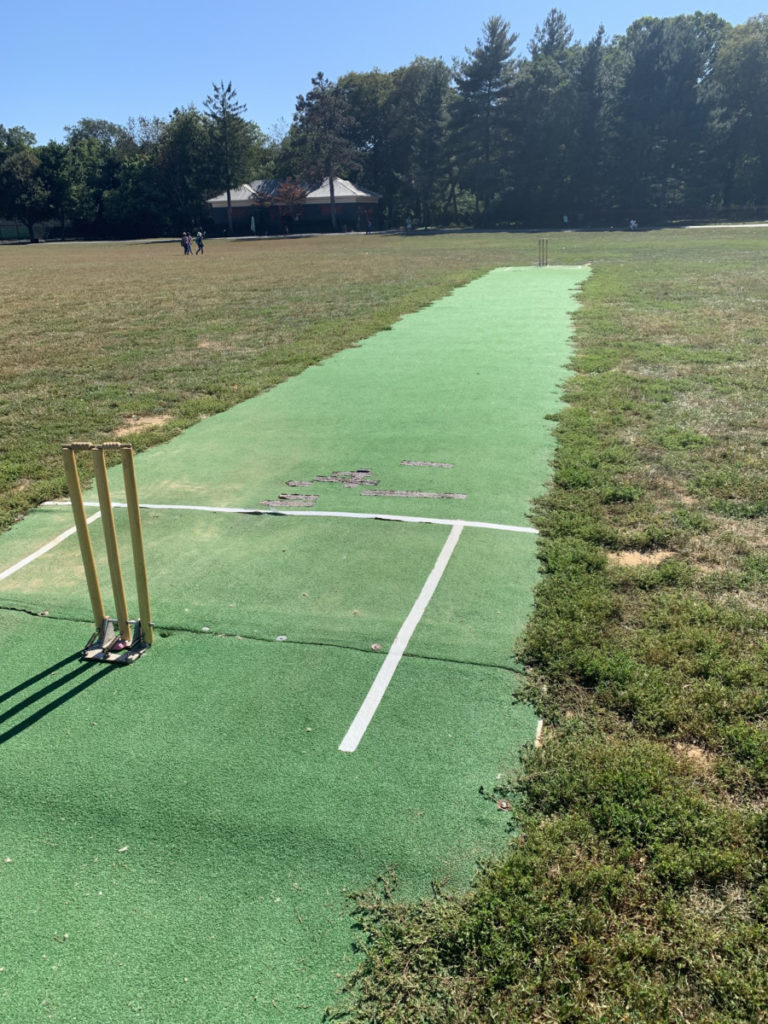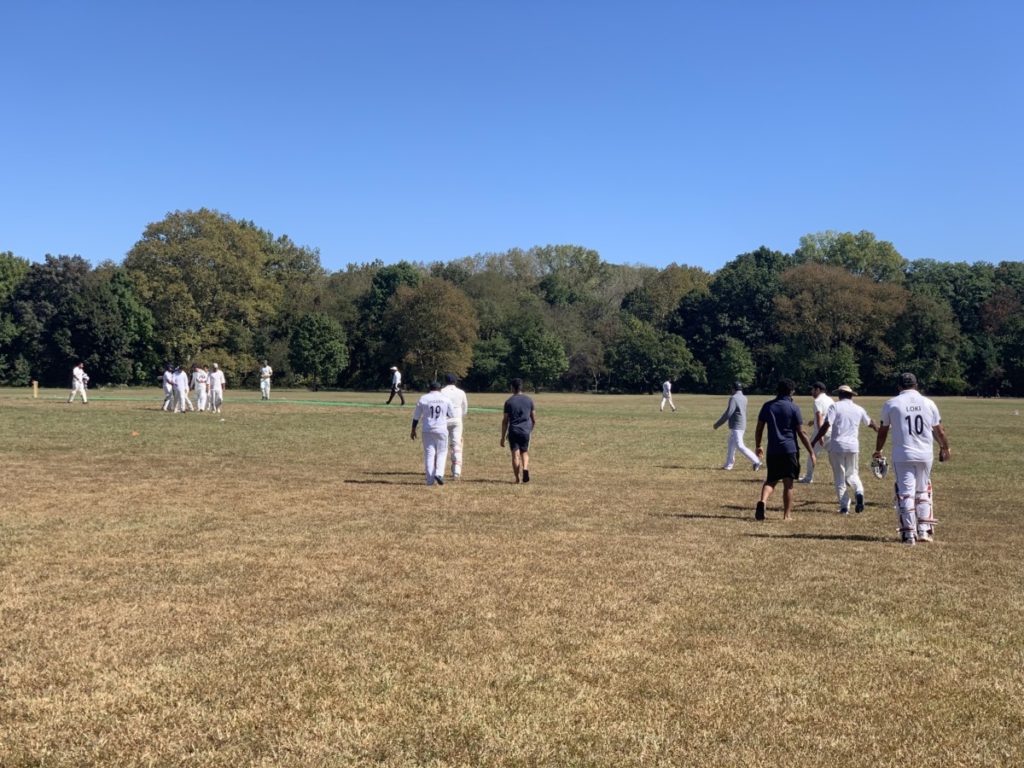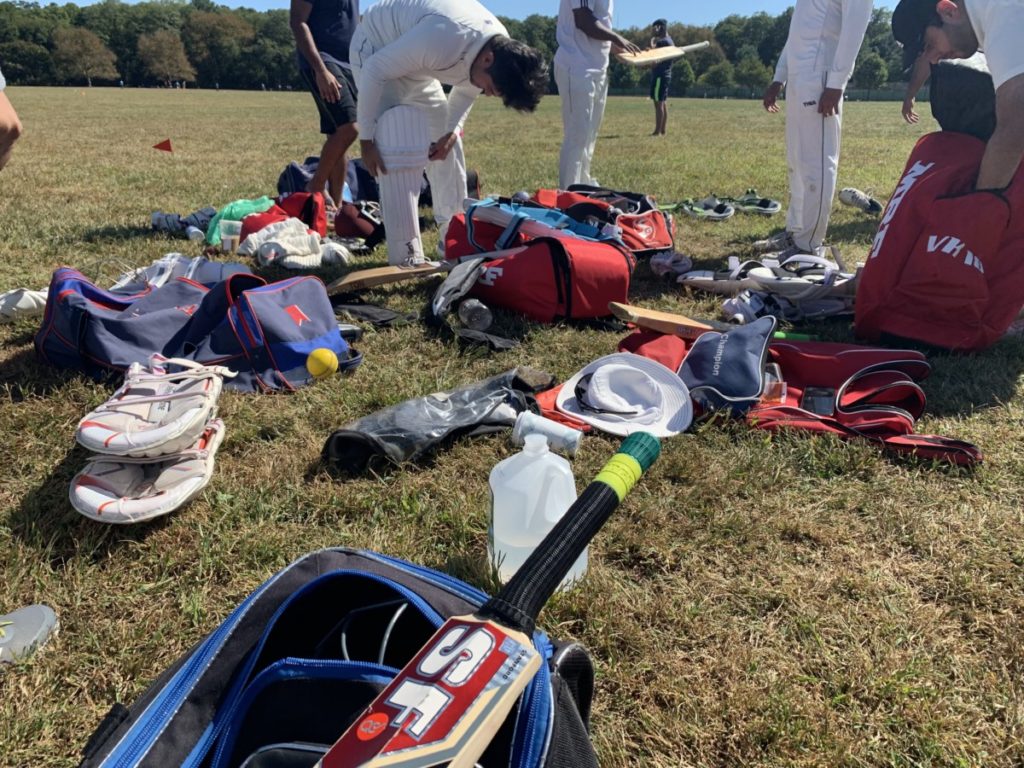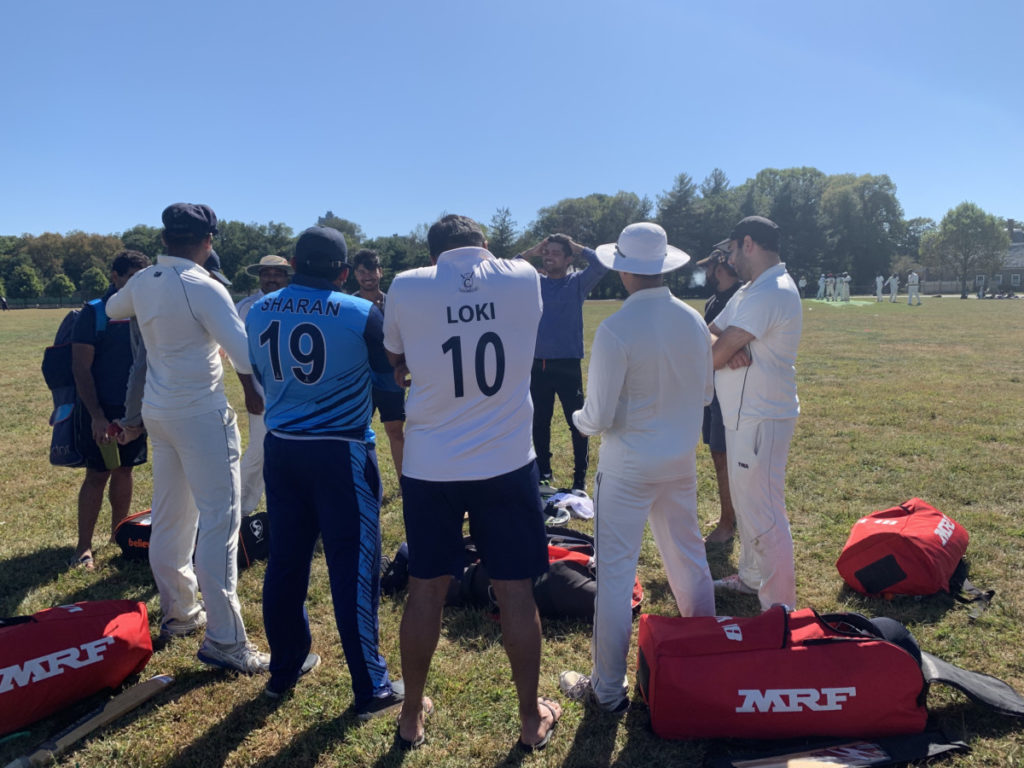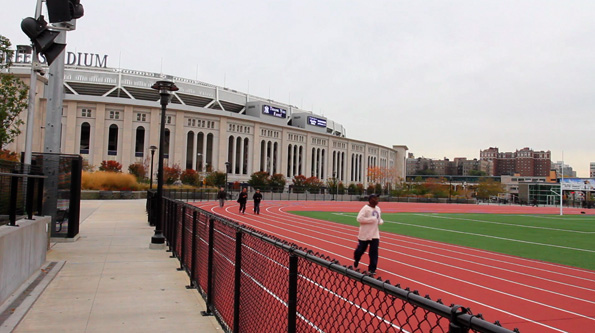
Yancey Field is a new track and soccer field built as a compromise to Bronx residents on top of one of the Yankee Stadium parking lots. (NIGEL CHIWAYA/Bronx Ink)
The parking was supposed to get better. That’s what New York Yankees president Randy Levine promised Bronx residents and city council members back in March 2006 when the team was negotiating for a new Yankee Stadium. By adding 3,000 parking spots, Levine said, Yankee fans would not need to cruise the streets looking for curbside parking spots. The result would be a less congested South Bronx.
Bronx residents don’t see it that way. According to them, things have actually gotten worse since the new stadium went up.
“It’s a nightmare,” said Joyce Hogi, who has lived on 165th Street and the Grand Concourse for over 30 years. “There are still people that are looking to park on the streets, but now the police block off 161st Street on game days. I have friends in Highbridge and it takes them two hours to get through.”
Decreased street congestion was just one of the four key promises the Yankees made in 2006. At that city council meeting Levine also pledged to create new public parks to replace those lost during stadium construction, to establish a benefits fund for Bronx non-profits, and to provide 1,000 permanent new jobs at the stadium.
But five years after the team broke ground on the new stadium, the parking garages sit half empty during game days, the benefits fund has come under fire for the way it manages the money, and no one is exactly sure how many Bronx residents work in the stadium.
While the city may have determined that the new Yankee Stadium was worth over $60 million to New Yorkers, those who live next door to it in the South Bronx believe is not nearly as valuable.
“All you have to do is look around to see that it wasn’t worth it,” said Ramon Jimenez, who runs the For the South Bronx Coalition, a community group that has been trying to pressure the Yankees into living up to their promises since 2009. “The new Yankee Stadium has not added to the community.”
Requests to the Yankees organization and city council members Helen Foster, Joel Rivera and Maria Carmen del Arroyo for comment were denied. Bronx Borough President Ruben Diaz did not return calls to the Bronx Ink.
Parking garages: The increase that nobody needed
“The same number of cars and buses already come to the stadium. However, today, they just park all over the street, and all over the community… It causes disruption. So we’re trying to fix it. By building the new parking spots, the cars will get out of the community. Won’t circle around the community and disrupt it. And will go into parking lots.” -Randy Levine to New York City Council, March 28, 2006
As part of the stadium proposal, the Yankees asked the city and state to build about 3,000 new parking spaces. Critics balked at this request, citing the fact that 7,000 parking spaces already existed and the current stadium would seat almost 4,000 fewer fans. Additionally, the stadium is located along the busiest subway station in the Bronx and the MTA planned to build a Metro North station a few blocks away, providing car-free transportation for Yankees fans from upstate New York. Finally, even the best parking garages wouldn’t attract those that were determined to park for free on the street.
“Additional parking spots doesn’t necessarily mean the fans are going to elect to park in those garages,” said Councilmember Maria Arroyo at the 2006 meeting. “And as long as there’s free community parking, they may opt to do that before they go into the garage.”
Nonetheless, the City Council approved the Stadium along with the new parking facilities in April 2006 and the city’s Economic Development financed the parking garages with $237 million in public bonds. Three new garages were built: one adjacent to the new stadium and two across 161Street behind the old stadium. The city selected Bronx Parking Development Corporation; a company located 121 miles north of the Bronx in Hudson, New York, to operate the garages.
Five years later, the critics have been proven correct. Though the Yankees have drawn more fans than any other team in baseball since the stadium opened, the garages have struggled to reach 60 percent capacity. In fact, city records show that the parking garages were only 45 percent full during September 2011, when Yankee closer Mariano Rivera recorded his baseball-record 602nd career save.
The anemic performance of the garages has caused Bronx Parking to repeatedly alter its financial projections. The company expects to bring in only $12 million in revenue from the garages in 2012, down from the $22.6 million it projected in September 2010.
On top of the empty garages, Bronx Parking must repay the public bonds issued in 2006 and must make two payments of $6.9 million to the city in April and October of each year. Facing a revenue shortfall, financial records show that the company has had to dip into its cash reserves to make the last three payments, withdrawing $2.3 million in October of 2011. With only $9.2 million remaining in its reserves and facing a projected deficit of $8.3 million, Bronx Parking will have little choice but to reach into its reserves once again next year. The company’s own financial projects show that it is on pace to exhaust those reserves by April 2013.
Too many options
The garages have struggled to compete with free parking offered at the nearby Gateway Center. Budget-conscious fans leery of paying the $35 fee to park at Yankee Stadium have instead opted to pay the Gateway Center’s $10 fee.
“People are trying to save money,” said Jimenez. “So you park in the mall and you walk three blocks to the stadium.”
View Yankee Stadium Parking in a larger map Yankees fans have several options for traveling to and parking at Yankee Stadium. In the chart above, items in blue represent Yankee Stadium parking lots, items in red represent competing lots and items in green represent mass transit options.
And in direct contradiction to Levine’s promise, fans are still parking on the streets. “Seasoned fans that know they can find a spot on the street do that,” said Hogi. “It’s gotten so bad that we’ve tried to get a resident parking permit. The garages have not freed up the streets at all.”
Faced with an embarrassing default, the city has begun searching for exit strategies. In September, Bronx Borough President Ruben Diaz, Jr. announced a plan to tear down one of the garages and replace it with a hotel. Diaz, who admitted that the parking lots face “severe financial problems” in his 2011 state of the borough address, believes that replacing garage 8– the 1970’s-era garage that stood next to the old stadium– with a 200-300 bed “world class hotel” would be a win-win for the Bronx and Bronx Parking.
“This development would serve as a new tourism hub for our borough, while creating hundreds of good jobs for Bronx residents and greatly enhancing the area surrounding Yankee Stadium,” said Diaz.
Community Board 4, which voted against the new Stadium in 2005, is on board with the new plan. And while William Casari, a librarian at Hostos Community College who sits on the board’s parks commission, would rather see the garage turned into parkland, a hotel is better than nothing.
“If it’s done correctly, sure; it’s better than a parking garage,” Casari said. “But it’d have to be a Marriott or something. Not some government-assisted thing.”
Public Parks: The long wait to play
“There will be baseball and softball fields on the site of the original stadium, where Bronx and City kids will play on the same hallowed ground that Yankee greats from Ruth to Gehrig, to DeMaggio to Mantle, to Berra, to Jackson, to Rivera and Jeter have played. The new park will have a new running track, a new soccer field, new baseball and softball fields, new basketball courts, new handball courts, and new tennis facilities.”
-Randy Levine to New York City Council, March 28, 2006
Yancey Field is a racetrack and soccer field that sits across the street from the new Yankee Stadium. Every morning, even before she has her breakfast, Hadiyah Colbert runs laps around the track. Colbert, originally from Yonkers, is quite fond of the track.
“This one is cleaner,” said Colbert, who moved to the Bronx seven years ago. There used to be garbage in the old one.”
The track that Colbert runs on is part of a grand compromise that the parks department and the Yankees made with Bronx residents. The new Yankee stadium was built on top of Macomb’s Dam and Mullaly parks. To replace the destroyed parkland, the parks department spent $195 million rebuilding Macomb’s Dam Park across the street from the stadium. Yancey Field–part of the new park–sits on top of one of the stadium’s parking garages.
It didn’t come easily. Originally scheduled to open in 2009, Yancey field didn’t open until 2010, which meant that Bronx residents went four years without a track. Colbert made do by running around the remainder of Mullaly Park, but added that she would have preferred the old park.
“They didn’t need to build a new stadium,” Colbert said. “I think the money could have been put to better use.”
Baseball players have had to wait even longer. The area lost its only regulation baseball field when Macomb’s Dam Park was paved over. The parks department promised to replace it when Heritage Field–a complex of three ball fields built in the footprint of the old stadium–by 2010, but delays in the demolition of the old Yankee Stadium pushed the park’s opening date back to fall 2011. The park opened for one day in late November, when Little Leagues competed on the field. The park was then shuttered for the winter the next day. Casari said that he has noticed parks officers shooing residents away.
“Two guys with big bags for baseball bats were headed toward the field,” Casari said, “and the officers took them off the field.”
When they finally open to the public, the ball fields will require a permit to play on. While it children under 18 will be able to obtain a permit for free, adults will have to pay, which Jimenez said makes them less attractive to the community.
“The old parks were open,” Jimenez said. “This just doesn’t replace the old parks.”
Community Benefits Fund: money with no oversight
“As part of the benefits agreement that we’re negotiating, we’re talking about putting a very sizeable amount of money — I’ll give you a ballpark right now, about $700,000 a year, which, for each of 40 years, which will go to a committee… There will be a grant apparatus set up. That everybody in the community will come, make an application, and the people in the area, in the community, will decide which is appropriate, which is prioritized, and which is not. -Randy Levine to New York City Council, March 28, 2006
If the parking situation irritates Hogi, the Community Benefits Fund makes her seethe. To Hogi, the fund is another example of the lack of input given to the people of the Bronx.
“Nobody knows how much money is in there and how it’s handed out,” Hogi said. “It’s demoralizing to the community to be so left out of the loop.”
Despite its name, the Yankee Stadium Community Benefits Fund operates independently of the community and the Yankees. Created in 2006 as part of an agreement between the team and four Bronx politicians, the fund is a non-profit organization that handles $800,000 worth of grants provided annually by the Yankees. The fund has been a magnet for contention since its inception. While the Yankees said they began donating money annually in 2006, the fund’s committee wasn’t established until 2008.
According to the fund’s 2008 and 2009 tax documents, it has distributed over $1.6 million to several Bronx non-profit organizations. Records show that the Highbridge Community Life Center and the Highbridge Voices children choir received grants of $20,000 and $7,500, respectively, in 2009. However, groups outside of the community, like the Manhattan-based New York Road Runners club, which received a grant of $16,250 in 2009, also have access to the money.
“That money was supposed to benefit the people in the South Bronx,” said Jimenez. “It’s supposed to be for those who had to deal with the disruption the stadium caused. How does that money go to Throgs Neck and Riverdale?”
The fund came under further fire in September, when the New York Post reported that several groups without non-profit status were receiving grants. The groups in question include El Maestro, a Foxhurst boxing gym that was for-profit when it received $5,100 of sports equipment in 2009, and Flo-bert Ltd., a Manhattan tap-dance troupe that last filled out tax forms in 2007 yet still received $2,000 in 2009. Flo-bert’s non-profit status was revoked in 2010.
Serafin Mariel, the fund’s president and the former chief executive of National Bank, refused to comment or provide copies of the fund’s annual reports to the Bronx Ink. “I’m sorry, I don’t speak to reporters,” Mariel said.
Jobs: the unproven investment
“This new stadium will create thousands of construction jobs, and at a minimum, as President of the Yankees, I’m telling you 1,000 new, permanent additional to what we have, new permanent jobs at the new stadium. And they will be good jobs… A commitment by the Yankees to significant Bronx employment.”
– Randy Levine to the New York City Council, March 28, 2006
In the same agreement that created the fund, the Yankees also promised that 25 percent of all new jobs created at the new Yankee stadium would be reserved for locals. It is difficult to verify whether this promise has been fulfilled, however, because the Yankees have not provided figures.
Even so, Levine’s promise of 1,000 permanent jobs rings hollow. A 2009 report by former New York State Assemblyman Richard Brodsky revealed that the Yankees reported to the city’s Industrial Agency that they intended to add only 15 full-time jobs in 2009. And while the Yankees disclosed in a 2008 application for public funding that they would add 1,100 contract jobs, the majority of those jobs were in concessions.
If Bronx residents are outraged by the lack of transparency, they are powerless to combat it. Only five people signed the community benefits agreement: Levine, former Borough President Adolfo Carrion, and council members Arroyo, Maria Baez, and Joel Rivera. Only the politicians that signed the document have the legal standing to enforce its terms, and both Carrion and Baez are out of office.
This lack of community input has caused the community benefits agreement to be widely criticized as a sham that was thrown together to help the Yankees get their stadium.
“I’d give an ‘F’ to whoever drew up that benefits agreement,” said Jimenez, “if I thought they were drawing it up in the interests of the community.”
Bettina Damiani, Project Director at Good Jobs New York, a watchdog group that tracks government subsidies, summarized the community’s legal woes by saying: “there is no CBA – not a real one anyway – at Yankee Stadium.”
Unhappy anniversary
For Hogi, the anniversary of the groundbreaking is not one she cares to mark. In fact, these days she does her best to avoid the stadium altogether.
“If I have to be out driving on the game day I go all the way east and come around,” Hogi said. Part of her reason for staying away is to avoid the traffic, but part of it is to escape the irritating feeling of being right.
“Those of us that were really fighting the intrusion,” Hogi said. “Everything that we said would happen, has happened.”

